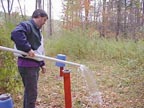
There are many reasons for monitoring, such as monitoring the movement of a plume, monitoring contaminant concentrations for health reasons, or to assess the rate of natural attenuation or the progress of an active remediation system. Monitoring systems can be expensive, and once in place, they can be very difficult to alter or stop the monitoring requirements, which can continue for years.
Some sites do not have enough monitoring and/or the sampling points or they are not in the right areas or at the proper depths. Usually this is because the flow system is not well understood. In the old days at landfills, the only monitoring requirement was one well upgradient and two downgradient. Without knowing the hydrogeologic conditions, this may not be adequate to achieve the purpose of the monitoring program.
I'm sure many of you are aware of sites that are "over monitored," such as sites having a dozen or more wells at a typical gas station or hundreds of wells at a chemical facility. In many cases, it really does require a large number of wells to adequately define the flow system, depending upon the number of source areas, complexity of the system, and the number of layers or aquifers beneath the site.
There are two areas where cost savings can be realized without compromising potential harm to human health or the environment. Ground water moves very slowly, on the order of inches to a few feet (fast) per day. Once a baseline of environmental conditions has been established (i.e., after a year and after at least four sampling events have been completed) and concentrations of compounds of site concern have been established, the frequency of sampling usually can be reduced to semi-annually or annually for selected wells. The second cost-savings measure involves reducing the number of compounds analyzed, especially compounds not suspected of being present on the site. If the compounds have not appeared above background levels for multiple sampling events, then the frequency can be reduced to annually or possibly discontinued all together.
Since ground water moves very slowly, abrupt changes in parameters monitored are not expected. Therefore, frequency of monitoring and the types of compounds analyzed can often be minimized or eliminated without compromising the purpose of the monitoring program. Monitoring is important, but the data needs to be reviewed and the program adjusted according to the site conditions.

Report Abusive Comment